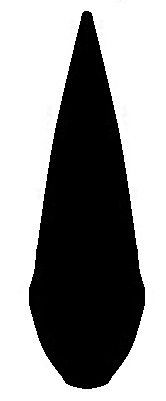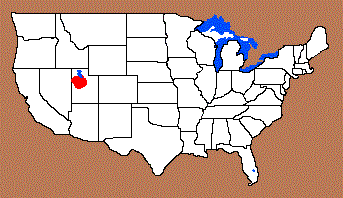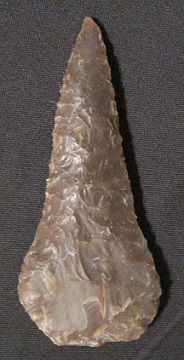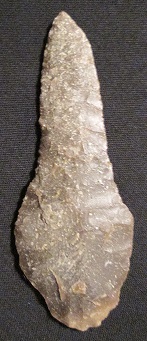

This is a medium to large lanceolate blade with an elliptical cross section. The blade may vary from excurvate, straight, or recurvate curving in at the tip and flaring out at the shoulder. The shoulders are weak to absent and at an upward angle. The stem is contracting with a pointed to convex base. The hafting region has basal grinding. This point may have a random to parallel horizontal flaking pattern.
Size Measurements: Data Needed
This point is primarily found in central Utah and into western Utah.

TIMPANOGOS BLADE (Stemmed & Lanceolate) – comes from the Aztecan word Timpanogostzis meaning ‘people of the rock’. The Timpanogos Indians, alternately called Eutahs were a native people living in Utah. This point type was named for examples recovered from sites near Mount Timpanogos in the Wasatch Mountain Range and Timpanogos Cave. It is yet another provisional point type from the far west. They are medium to large sized (3” to 5”) knives that are often found in caches. There are two forms, the stemmed form and the enlarged basal type that contracts to a straight, pointed or round base. Blade edges can vary and the stem areas can be short or very long. One variant has shallow side notches that create small tapered shoulders. They are similar to or the same as Wahmuza. Distribution is northwestern Utah and they were in use during the northern high plains Historic to Transitional phase. References: Anderson, Adrienne B. 1975, Archeological Evaluation, Timpanogos Cave National Monument. Anonymous 1979, Summary of Archeological Resources and Resources Management Needs for Timpanogos Cave National Monument. Prepared By Rmr Inventory of Archeological Sites Program, Midwest Archeological Center.


This name was used for examples found from American Fork Canyon that were associated with the Timpanogus Culture. Professionally, this name has only been used to describe these examples, and not this type as whole. This is considered a cultural type.
.